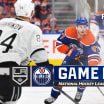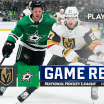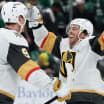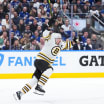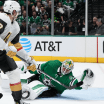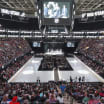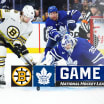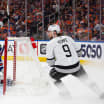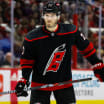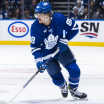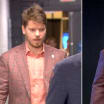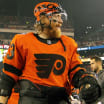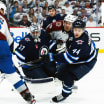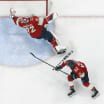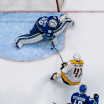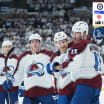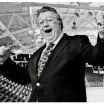Editor's note: Kenny Albert is usually a man on the move during the Stanley Cup Playoffs. A play-by-play announcer for the "NHL on NBC" and the radio voice of the New York Rangers, Albert is seemingly in a different arena, in a different city, at a different game every day during the NHL postseason. But with the 2020 postseason being held in bubbles due to the coronavirus pandemic, Albert has been in Edmonton since Aug. 5 to call Western Conference playoff games.
Here, he details life in the bubble for NHL.com:
Albert, NBC voice, details life in bubble during playoffs for NHL.com
Play-by-play man writes about staying in one spot, kicking field goals in Edmonton
A day with Kenny Albert Inside the Bubble
By
Kenny Albert / Special to NHL.com
Nothing about 2020 feels normal. For me personally, 2020 has included 146 straight days at home (beginning March 12 with the announcement of the pause to the NHL regular season), followed by 26 days (and counting) inside the NHL bubble in Edmonton. Never in my wildest dreams did I ever imagine having to spend four days inside a hotel room without the ability to step outside the door into the hallway, calling three playoff games in one day (twice), or daily pingpong matches at Rogers Place during the month of August.
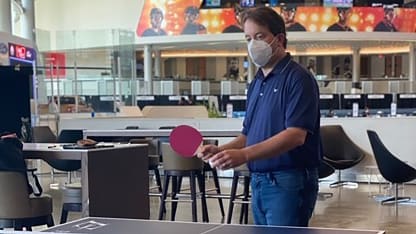
During the Stanley Cup Qualifiers, I called seven games off television monitors -- something else I never thought would be a reality. One of the great benefits to doing hockey play-by-play is calling games from arenas all across North America, with the energy and enthusiasm from the crowd a major facet in conveying the excitement of what's taking place on the ice to the listeners and viewers at home. I worked four games from a small booth at the NBC studios in Stamford, Connecticut, and called three New York Rangers games with my partner Dave Maloney from the ESPN Radio studios in Manhattan. Calling games off monitors isn't ideal; however, it went smoother than I anticipated. There are definitely challenges, such as when a penalty is committed away from the play and off-camera.
On Aug. 5, I boarded a flight for the first time in nearly five months for the trip from New York to Edmonton. Upon arriving to the hotel, my temperature was taken by a health care worker in the lobby and I headed to my room knowing I would not be able to leave for four full days. Less than an hour later, I received a knock on my door -- it was time for the first daily COVID test. Everyone in the bubble (players, coaches, team staff, NHL staff, broadcasters, hotel employees, etc.) is tested every day. During quarantine, the daily test took place in my room. To help make me feel at home, my wife and daughters snuck photos of themselves into my luggage, which I immediately taped onto the hotel room mirror. It was surreal to look outside the window at Rogers Place (approximately three blocks away) while three games were being played there each day. Fortunately, there were five or six games on television every day during my quarantine (including the Eastern Conference games from Toronto), giving me a hockey fan's dream from 10 a.m. until midnight! I also spent a lot of time preparing for my upcoming games, watched a few movies, did a lot of reading and ordered every meal via room service (which was left outside my door). Two days later, I felt like a free man when I was finally released from quarantine Aug. 9.
With no games Aug. 10, the off day between the Qualifiers and the first round of the Stanley Cup Playoffs, I explored the areas those of us inside the Edmonton bubble are able to go -- three hotels (cut down to two after the Qualifiers), the arena and a plaza area outside Rogers Place that includes three food trucks, two basketball hoops, cornhole games and approximately 10 high-top tables with stools. Players, coaches, general managers and officials constantly spend time in the plaza -- getting fresh air and picking up coffee at the Tim Hortons truck or lunch at one of the other food trucks. On the off day, I spent about a half-hour shooting hoops in the plaza.
The next day I was off and running with Game 1 of the series between the Dallas Stars and Calgary Flames, followed by a total of 10 games over the next five days. As I write this column Aug. 31, Pierre McGuire, my broadcast partner on NBC, and I have called 25 games, involving 12 teams, during the past 20 days, with many more in the days and weeks ahead. Eddie Olczyk and AJ Mleczko have joined us on some broadcasts from remote locations as well. On the second three-game day, two of the games went to overtime -- a total of 11 periods of hockey in less than 12 hours. I felt like I could've called a fourth game! The adrenaline takes over during multigame days, similar to my past experiences calling men's and women's hockey at the past five Winter Olympics. I would imagine it is similar to what my peers go through with four-game days during March Madness. During last spring's Stanley Cup Playoffs, I worked 27 games over four rounds for NBC and Westwood One Radio in nine different cities -- two months filled with myriad early morning flights and checking in and out of numerous hotels. Since Aug. 11, all of my broadcasts have been from the same booth in the same arena…while staying in one hotel room.
The NHL has done a terrific job with sound effects in the building during play, as well as music and goal songs from every team's home arena; they add to the ambiance for the small number of us in the building and the viewers at home (and help raise my energy level). Kudos to NHL chief content officer Steve Mayer and his entire staff! NBC, Rogers Sportsnet and the local affiliates in NHL markets (during the Qualifiers and first rounds) have done a magnificent job production-wise to bring hockey fans around the world closer to the action without actually attending games. One of the officials told me that due to the lack of fans, the referees and linesmen can actually hear my play-by-play at times on the ice during the games! Hopefully I have been kind to them. During the five games I did not work in the first round, I sat just to the left of our broadcast booth; I was one of the only people in the building watching the game yet not working in some capacity. Without wearing a headset (as I do while working), I was amazed at how much of the communication and chatter I could hear from the players on the ice and team benches while sitting approximately 20-25 rows from the ice.
Once the second round began, the days have become much less hectic, with only one game per day (except for a doubleheader on Sunday). Every day feels like Groundhog Day: a few hours of prep work in the morning; walk to the arena around noon for the daily COVID test (nose swab on even-numbered days, throat swab on odd-numbered days), followed by fierce pingpong matches, then lunch. On some days, a trip to the hotel gym in the late afternoon (where Pierre and many NHL officials are usually taking part in their personal Tour de France); then a game at night (Dallas vs. Colorado and Vegas vs. Vancouver on alternating days). The League also offers daily availability (via a 10-minute bus ride) at the local Canadian Football League stadium, allowing those in the bubble to enjoy fresh air, throw a football or frisbee around, or kick a soccer ball. A few teams have taken advantage; in fact, Nick Holden of the Golden Knights kicked a 55-yard field goal! I asked him about it at the arena when I randomly bumped into him prior to Game 2 of against the Canucks. Holden told me he played a lot of soccer as a youngster. During my trip to Commonwealth Stadium, after missing a few attempts from longer distances, I finally was able to hold my head high after connecting from 15 yards out. I guess a career as a placekicker is not in the cards.
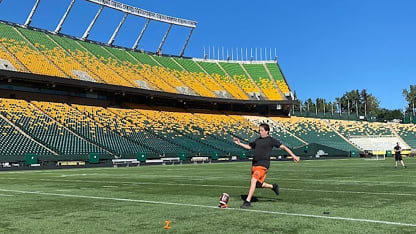
Every day begins with a temperature check in the hotel lobby. It takes less than 30 seconds via a phone app and a CLEAR machine (also located in the entrance to Rogers Place). Every time anyone in the bubble enters or leaves a hotel or enters the arena, we must show the app with a green screen (meaning your temperature is fine) to a member of the security team. If your screen turns red after a temperature check, you must immediately have your temperature taken by a health care professional located at either the hotel or arena. I can't emphasize enough what an amazing job the NHL has done in setting up the bubbles in both Edmonton and Toronto, as well as the health protocols that have worked to perfection. Face masks are mandatory at all times, aside from when I'm broadcasting, eating or alone in my hotel room.
The food has been very good, although all of us in the bubble have eaten at the same places multiple times: the hotel restaurants, the food trucks outside the arena and Studio 99 on the fifth floor of Rogers Place, which is filled with Wayne Gretzky memorabilia. During multigame days, Pierre and I would grab a quick meal at Studio 99 and watch the Eastern Conference games on a big screen while surrounded by players, coaches and management from other teams as well as NHL staff. Following the Vancouver Canucks' series-clinching win against the defending Stanley Cup champion St. Louis Blues, we ate dinner at one of the hotel restaurants a few tables away from the entire Canucks team.
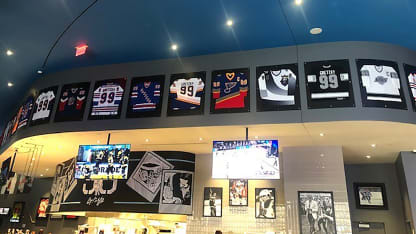
We have witnessed hockey history twice in Edmonton, each time involving the Stars. In Game 6 of the first round against the Flames, the Stars became the first team in the history of the Stanley Cup Playoffs to trail by three goals, then take a four-goal lead. In Game 3 of the second round, the Colorado Avalanche, playing against Dallas, were the first team in postseason history to lead a game by two goals in the third period, fall behind, then restore their two-goal lead.
Walking through fencing from the hotel to the arena with security guards every 50 feet along the way, daily temperature checks and COVID tests were the furthest thing I would have ever envisioned prior to 2020, as was calling 17 of the 22 Western Conference games played in the first round and every game in the second round. But aside from spending time at home with my family (which I did every single day from mid-March through early August), there is no place I would rather be!
